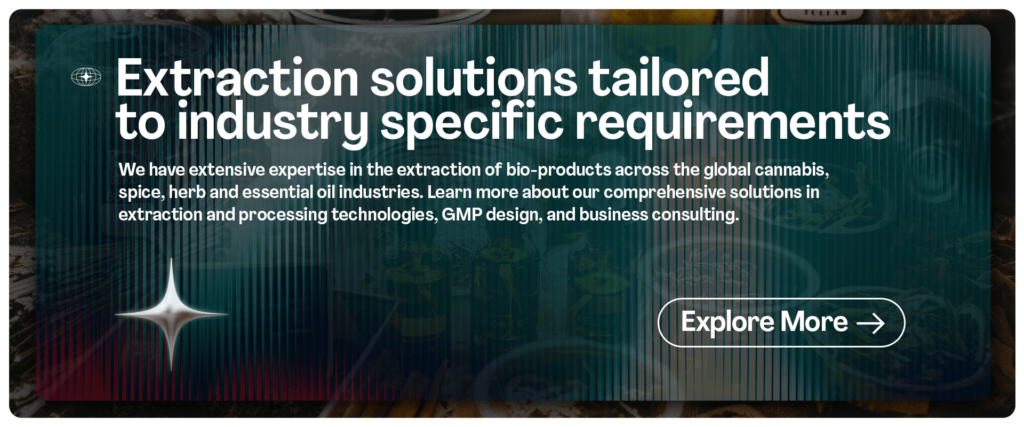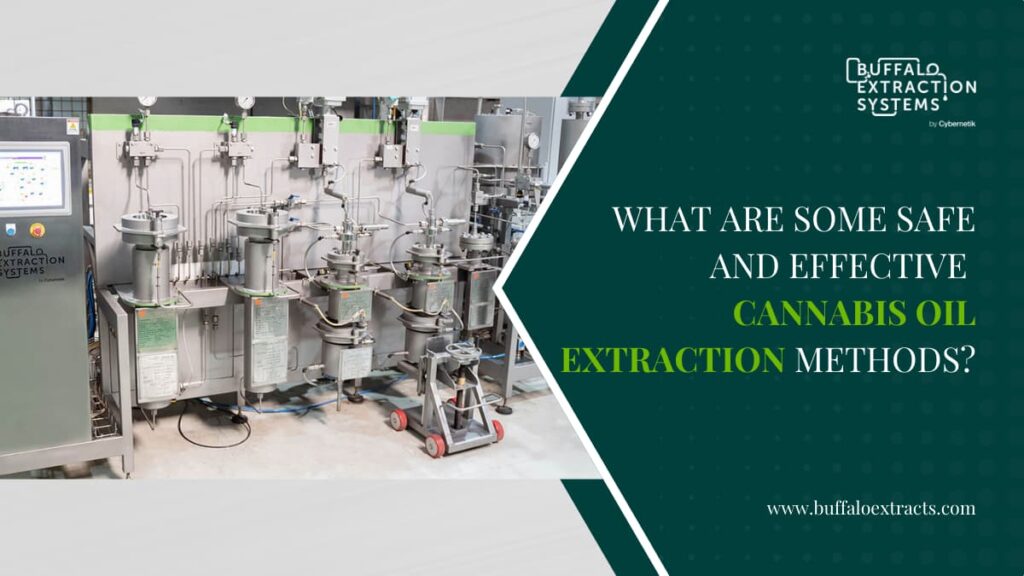Exploring Safe and Effective Cannabis Oil Extraction Methods
Cannabis oil extraction is a pivotal process in the production of various cannabis-based products, ranging from medicinal oils to recreational concentrates. The extraction method's choice profoundly impacts the final product's quality, safety, and potency. This comprehensive exploration delves into eight distinct cannabis oil extraction methods, each with its advantages and considerations.
From the technologically advanced CO2 extraction for essential oils to the solvent less simplicity of rosin pressing, we provide detailed insights into these methods. The aim is to offer a balanced perspective for both enthusiasts and professionals seeking safe and effective ways to harness the potential of the cannabis plant.
Here are some methods:

- CO2 Extraction: Is a technologically advanced method that utilizes carbon dioxide in a supercritical state. In this state, CO2 behaves both as a gas and a liquid, making it an excellent solvent for separating cannabinoids and terpenes from the cannabis plant material. This method is renowned for its safety, as CO2 is non-toxic and non-flammable. Because the extraction and separation are based on pressure and temperature difference of supercritical CO2, there is no residue in the final product. CO2 extraction allows for precise control over temperature and pressure, which is crucial for preserving the delicate compounds within the cannabis plant, resulting in a high-quality extracts. The final product is often favored in both medical cannabis extraction and recreational cannabis markets. This method is renowned for its safety, as CO2 is non-toxic and non-flammable. Because the extraction and separation are based on pressure and temperature difference of supercritical CO2, there is no residue in the final product. CO2 extraction allows for precise control over temperature and pressure, which is crucial for preserving the delicate compounds within the cannabis plant, resulting in a high-quality extracts. The final product is often favored in both medical cannabis extraction and recreational cannabis markets.
- Ethanol Extraction: Involves soaking cannabis plant material in ethanol to dissolve the desired compounds. This process is relatively straightforward and cost-effective. While ethanol is considered a safe solvent when handled properly, it can also extract undesirable components such as chlorophyll, waxes, and lipids, potentially affecting the taste and quality of the oil. To mitigate these issues, many producers use a post-extraction process called winterization to remove impurities. Ethanol extraction is widely used for its efficiency and broad spectrum extraction of cannabinoids and terpenes.
- Butane or Propane Extraction (BHO/PHO): Often referred to as BHO or PHO (propane hash oil), these methods are popular among cannabis enthusiasts for their ability to produce highly concentrated extracts with strong flavors and aromas. However, these methods carry inherent risks due to the potential flammability and explosivity of butane and propane. Safety precautions, such as using specialized equipment and working in well-ventilated areas, are essential. After extraction, the oil must be thoroughly purged to remove any residual solvents. The resulting BHO or PHO extracts are potent, and commonly used in products such as shatter, wax, and oil cartridges.
- Olive Oil Extraction: Is so safe and simple, you can perform it at home. It involves heating cannabis plant material in olive oil to activate the cannabinoids through decarboxylation and dissolve them into the oil. Because olive oil is non-toxic and non-flammable, this method is considered safe for DIY enthusiasts. However, the resulting oil may be milder compared to extracts from other methods. It is often used for homemade edibles and topicals, providing a gentle and flavorful infusion.
- Rosin Pressing: A solventless extraction method, that the method has gained popularity due to its simplicity and safety. It uses heat and pressure to squeeze the resin-rich trichomes from cannabis flowers or hash. The absence of solvents ensures a pure and clean final product, preserving the full spectrum of cannabinoids and terpenes. While rosin may not reach the same potency as some solvent-based extracts, it is prized for its flavor and purity, making it a preferred choice among those who value the natural qualities of the plant.
- Water Hash or Ice Water Extraction: Relies on the use of ice-cold water and agitation to separate trichomes from cannabis plant material. This solventless method is considered safe and environmentally friendly. The process is labor-intensive, involving multiple steps such as mixing, sieving, and drying. The quality of the final product can vary depending on the skill of the extractor and the starting material, but it is generally considered clean and full-spectrum.
- Supercritical Hydrocarbon Extraction: Similar to CO2 extraction, the application of supercritical fluid extraction however uses hydrocarbon solvents such as propane or butane in a supercritical state.While it can yield high-quality extracts, it also carries safety risks due to solvent flammability. Therefore, it requires rigorous safety measures, including explosion-proof equipment and proper ventilation. After extraction, thorough purging is necessary to remove any residual solvents, ensuring the product meets safety standards. The supercritical co2 extraction process is favored by some producers for its efficiency and ability to create potent and flavorful extracts.
- Steam Distillation: Is a safe method that uses steam to extract essential oils, including cannabinoids and terpenes, from the cannabis plant material. However, it is less efficient compared to other extraction methods and is often chosen for specific applications or when a particular compound needs to be isolated. The resulting essential oil is typically less potent than extracts produced through other methods but may have unique uses in perfumery, aromatherapy, or the creation of specific cannabis-based products.
Exploring Cannabis Oil Extraction Methods: Maximizing Quality and Efficiency
Various cannabis oil extraction methods have emerged to cater to different product requirements and consumer preferences. Each method offers a different set of advantages and challenges impacting the final product quality, potency and safety. Factors such as desired consistency, terpene preservation, and cost influence the selection of extraction methods.
Major cannabis extraction processes to maximize quality and efficiency are:
- Supercritical Fluid Extraction: Uses carbon dioxide in the supercritical state to act as a selective solvent. Precise control over the parameters allows for precise extraction of different compounds.
- Cryogenic Ethanol Extraction: Uses ethanol at cryogenic (very low, about -40 deg-C) temperatures to extract cannabinoids and terpenes. Rapid freezing of plant material helps boost extraction efficiency.
Common Cannabis Oil Extraction Methods
The cannabis industry utilizes a variety of methods to extract valuable compounds from the plant. Here's a breakdown of common cannabis extraction methods:
- Supercritical Fluid Extraction (SCFE): Employs carbon dioxide above its critical pressure and temperature to extract cannabinoids and terpenes efficiently.
- Hydrocarbon Extraction: Involves using hydrocarbons such as butane or propane to extract concentrated oils.
- Ethanol Extraction: Uses ethanol as a solvent to extract products from cannabis raw material.
- Dry Sieve Extraction: A mechanical process involving sieving to separate trichomes from plant matter.
- Cryogenic Ethanol Extraction: Employs ethanol at very low temperatures for highly selective and rapid extraction. With SCFE, it is a premier cannabis extraction process.
- Olive Oil Extraction: Infusing cannabis in olive oil for consumption.
- Water Hash Extraction (Ice Water Extraction): Using ice and water to separate trichomes from plant material.
Ultrasonic Extraction: Using sound waves to extract compounds from plant material.
Buffalo Extracts’ Cannabis Oil Extraction Solutions
Buffalo Extraction Solutions is a leading provider of cannabis oil extraction solutions, specializing in separating the required products from raw plant material. With a focus on efficiency and scalability, Buffalo Extracts offers comprehensive services, including:
Core Offerings:
- Turnkey Operations: Entire cannabis extraction process from start to finish, providing a one-stop solution for clients.
- Advanced Equipment: Cutting-edge technology, employing both supercritical CO2 and cryo-ethanol extraction methods.
- Expert Support: Beyond equipment and processes, Buffalo Extraction Solutions offers invaluable expertise. The team of industry professionals provides guidance on optimizing the extraction process.
Benefits to Cannabis Producers:
- Streamlined Operations: Turnkey approach simplifies the production process, allowing producers to focus on other aspects of their business.
- Better Product Quality: Use of advanced extraction methods results in superior cannabis extracts with desirable potency and flavor profiles.
- Maximum Profitability: Optimized processes and high-quality products contribute to increased revenue and a stronger market position.
Such holistic use of various cannabis extraction methods puts all stakeholders in a win-win scenario.
Choosing the Right Cannabis Oil Extraction Method
Cannabis oil extraction methods are complex processes, each with its own distinct advantages and drawbacks. Different extraction methods have different impacts on the final product quality, potency and cost. Selecting the right extraction equipment is crucial for producers seeking high quality extracts that meets the market demands.
Choosing the right cannabis extraction process depends on several factors. Key considerations include:
- Desired Product: Select equipment based on which product you intend to extract from cannabis raw material.
- Cost-Efficiency: Considering the initial cost as well as operating costs.
- Yield: Maximizing oil extraction from plant material.
- Scalability: Ability to increase production as needed.
- Safety: Handling flammable solvents and ensuring safety as well as product purity.
- Legal Compliance: Adhering to local regulations and compliance.
Supercritical Fluid Extraction (SCFE) and Cryogenic Ethanol Extraction are among the more expensive and complex cannabis extraction methods, but offer the advantage of pure product extraction, high yields, and scalability.
Benefits of Using Buffalo Extracts’ Extraction Solutions
Buffalo Extraction Solutions deliver high quality equipment for cannabis extraction methods. With turnkey solutions, advanced equipment, and expert support, the cannabis extraction process gets organized. Buffalo Extracts offers a range of advantages for cannabis oil extraction:
- Streamlined Operations: Turnkey solutions, automated systems, and scalable processes cut the clutter out of the cannabis oil extraction methods, providing sleek cannabis oil extraction methods.
- Premium Extracts: Advanced extraction technology ensures high-quality products that are rich in CBD and terpenes, while skipping the removal of unwanted products.
- Expert Guidance: Industry knowledge and technical support at the practical level provides optimal results that can be replicated independently.
- Cost Efficiency: Reduced waste and increased high quality output means that the initial investment in the extraction system is more than recovered.
- Proven Success: Partner with a trusted leader in cannabis oil extraction.
In conclusion, Buffalo Extraction Solutions empowers cannabis oil producers to optimize their operations, elevate product quality, and achieve greater profitability through advanced technology, expert support, and proven industry leadership.
To Conclude
As the cannabis industry continues to expand and evolve, the importance of safe and effective extraction methods cannot be overstated. Each method discussed in this exploration offers a unique set of benefits and considerations.
CO2 extraction stands out for its precision and purity, while ethanol extraction offers cost-effectiveness. Solvent-based methods like butane and propane extraction provide potent concentrates but require rigorous safety precautions. On the other hand, solvent-less techniques such as rosin pressing and ice water extraction provide simplicity and purity.
Ultimately, the choice of medical cannabis extraction method should align with the specific goals, resources, and safety protocols of the producer. With careful consideration and adherence to best practices, the cannabis industry will continue to produce high-quality oils that meet the diverse needs of consumers while ensuring their safety and satisfaction.

